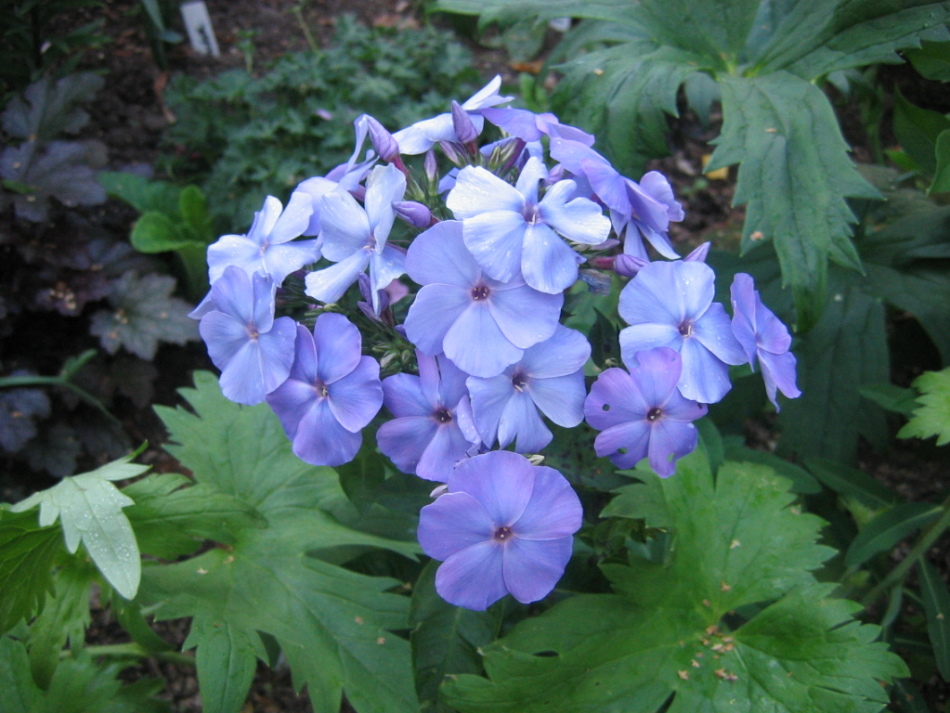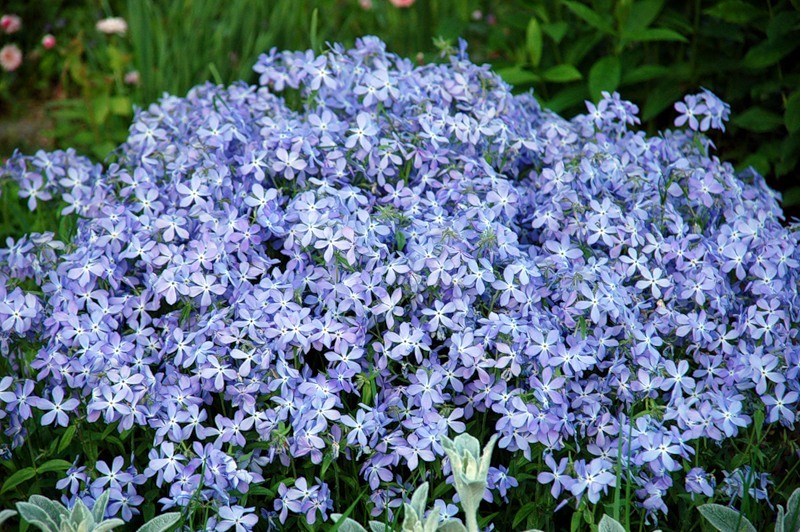Types and varieties of phlox. Features of growing phlox. Flox diseases. Flox awl and phlox Drummond is a description of varieties.
Content
- Flocas varieties: photo
- Flox Shilled Perennial - Types: Photos
- How to plant when you can transplant perennial phloxes?
- Planting phlox in the ground for many years in spring, in autumn roots, cuttings
- How to transplant phlox in the summer?
- Floxes - top dressing in the spring: what fertilizers do phlox love?
- Flocus care in the summer
- Floxes have faded - what to do next, how to cut phlox after flowering?
- Perennial phloxes - illness, treatment
- Why do not bloom perennial phlox?
- White plaque on the leaves of phlox: powdery mildew - what to do?
- Why are they twisting, turning yellow and blackened by the leaves of the phlox: what to do?
- How to treat phlox from disease?
- Flox Drummond Annual - Varieties: Photo
- Flox Drummond Annual - Growing from seeds
- Flox Drummond: When to plant seedlings?
- How to feed phlox for abundant flowering?
- What to plant next to phlox?
- How to plant and care for phlox: video
- Diseases and treatment of phlox: video
Floxes are favorites of many gardeners in the world. For our latitudes, this is an unpretentious plant, whose homeland is considered North America, is suitable in the best way. Due to their adaptability to the climate of our country, phloxes are able to delight their owners in their summer cottages with a variety of colors and aromas for the entire garden period.
Flocas varieties: photo

As mentioned above, phloxes are both annual and perennial.
Perhaps one of their only representative in our country - Flox Drummond, belongs to annual varieties of phloxes. This type of phlox will be discussed later.
Depending on the shape of the sheet, the phlox is divided into the following types:
- smiling
- shilled
- spread out
- bifurcated
Based on the height of the stem of the flower and whimsiness to the soil, the phloxes are classified into such subgroups:
- forter or laying
- fools
- nit -growing
- bush
- high bush
The most popular varieties of blizzard phlox are the following varieties:

















The soil phlox includes the following varieties:




The following varieties of phloxes can be attributed to loose phlox:



The following varieties of phloxes are considered by bus plants:





The following varieties of phloxes include low -growing phlox:









Flox Shilled Perennial - Types: Photos

Flox Shilovichi is a perennial plant, and it can bloom even a couple of times a year (in May-June and August-September). True, the second flowering of this plant may not be too bright and magnificent.
Flox Shille -shaped refers to the ground cover, stunted phlox. In height, as a rule, it can reach 15-20 cm.
The flood petals of the phlox of the awl have a pointed shape - it is this feature that determined the name of the subspecies. The length of one petal on average is 2cm.
Depending on the variety, the phlox is awkward can be of various colors - white, blue, pink. In addition, the plain background of the flower can decorate numerous dots, spots or strips of contrasting colors.
The most popular in our latitudes are the following varieties of the phlox of the awl:




How to plant when you can transplant perennial phloxes?

When planting phlox in the ground, it is necessary to take into account the following criteria for choosing a place for landing:
- soil yield - phloxes love rich and fertile lands
- soil moisture - for most types of phloxes, constant reciprocation of moisture is extremely important
- the location of the plot according to the Sun - as a rule, all types of phlox prefer shaded or to the extent illuminated places of the garden - planting in open sunny areas can lead to bleaching of flloom petals
Floxes can be planted at any time of their vegetative development - in the spring, summer, autumn.

The transplantation of phloxes can also be carried out throughout the landing period. However, there are a number of the most favorable periods and sensible tips for this manipulation:
- in the spring, phlox is best transplanted in late April - early May
- the most optimal summer-autumn period of phlox transplanting falls at the beginning of August-until the middle, flowers should already be transplanted
- in the fall, phloxes are best transplanted by stopping their tops in advance
- if you transplant phlox during its flowering period with a whole color, then you need to dig it very carefully
Planting phlox in the ground for many years in spring, in autumn roots, cuttings
The propagation of perennial phloxes is most often carried out in two main ways - cutting and dividing the bush with roots.
Division of the bush of phlox

The reproduction of phlox by dividing the bush can be carried out at any time of the year - early autumn (until the first frosts), in the summer in cloudy weather and spring.
The algorithm of actions:
- Gently dig the bush, trying not to damage the roots
- Shake off from the phlox earthen lump
- We unravel the rhizomes of the plant
- We divide the bush into several new bushes (you can use a disinfected knife).
Division with cuttings

- At the end of spring or early summer, we cut off shoots with two pairs of leaves on each of them (cut the bottom right under the lower sheets, and the top is 1 cm above the upper ones)
- Remove the lower leaves, and cut the upper ones half
- We dig up shallow pits for phlox at a distance of 6 cm from each other and 10cm between the rows and thoroughly fill them with water
- Pour into wet, but without water, fossa of sand in 1-2cm
- We insert the cuttings of the phlox into the prepared soil and seal it around the plant with your fingers
- Drink a little more land
- Cover the cuttings of the phlox and cover them with a film
- Water phloxes a couple of times a week
- When the first leaves appear on the stems, we remove the shading
- At the end of July - in early August, we transplant the sprouts of phlox to another place at a distance of 20cm from each other
- Holding the phloxes in their habitat for two years, in the third year we transplant them to a permanent place
If you carry out a similar procedure with phlox cuttings in summer or autumn, then at the root stage they need to be placed in a greenhouse, and before planting, it is kept in a growth stimulant for 10 hours.
How to transplant phlox in the summer?

- If you transplant phlox in the summer, then they need to ensure regular and abundant watering
- Also, during the process of transplantation, it is necessary to leave a good earthen lump on the rhizome of plants on the rhizome
- When transplanting phlox in the summer, their top is recommended to cut off the entire power of the plant to its rooting, and not to flowering
Floxes - top dressing in the spring: what fertilizers do phlox love?

Although it is believed that phloxes are rather unpretentious plants, however, so that they grow actively and colorfully, it is advisable to regularly fertilize them.
It is necessary to feed phloxes at least three times a year.
The following types of top dressing are best for fertilizing phlox:
- Manure (in autumn - horse, and in the spring - cow)
- Humus
- Compost
- Ash
- Nitrogen fertilizers (urea)
- Phosphorus fertilizers
- Potassium fertilizers
Nitrogen, phosphorus and potassium fertilizers should be used very carefully for phlox - it is necessary to adhere to the instructions for fertilizer.
For spring top dressing, compost with urea is best suited (half a bucket of humus should be added one tablespoon of urea). It is advisable to gently lay out the resulting subcorte under the plant.
Flocus care in the summer

Flocus care in the summer period consists of a whole set of events:
- Regular watering - soil under phlox should never be too dry
- Mulching the soil allows moisture to linger longer in the ground
- Fertening in the summer can be performed according to several schemes:
- Early June-manure with superphosphate, early July-diluted clean manure, end of July-potassium-phosphorus fertilizers
- At the beginning of summer-humus with urea, the period of budding-a couple of tablespoons of mineral fertilizers for flowering plants, after the end of flowering-phosphorus-potassium top dressing
- The fight against diseases and pests
- Getting rid of faded buds will help maintain flowering longer and increase the number of flowers for the next season
- Timely transplantation of phlox allows the plant to develop and multiply
Floxes have faded - what to do next, how to cut phlox after flowering?

A very important stage in the process of growing phlox is their preparation for winter.
After the phloxes bloom, they need to be trimmed so that the plant is safely wintered, and in the spring it is ready to delight its owners with bright and dense flowers.
There are two ways to pruning phlox:
- To the ground level - this method is suitable for cold snow latitudes and allows us to prevent the spread of bacteria over the plant
- By 5-10cm above the soil level-this method is suitable for more southern, low-snow latitudes and helps to delay the snow over the plant to feed it with moisture
All cut bushes of phlox must be removed from the site and burned.
The next step in preparation for winter is the top dressing of soil and plants. As an autumn feeding of phloxes, a tablespoon of mineral fertilizer, laid out under each bush, is perfect. It is also recommended to fertilize the phlox ash.
7-10 days after feeding, the phlox must be covered with peat, humus, compost or simply dry leaves.
Perennial phloxes - illness, treatment

Floxes, like any other plants, are subject to diseases and attacks of various kinds of pests.
The most common diseases of the phlox are considered:
- powder
- nematode
- rust
- white verticelle withering
- mosaic
- the fading of the color
- grinding leaves
- spotting
- variegation
- alternariosis
- fomosis
A insect-pests for phlox are a beetle-shchelkun, an earwright, caterpillars and a slobbery Pennitsa.
Floxes have larger enemies - snails and slugs.
Why do not bloom perennial phlox?

The lack of flowering phlox can be explained by the following factors:
- sunny rays failure
- unknown or poorly mulched earth
- lack of moisture or, conversely, stagnation of water
If at least one of the listed conditions is not fulfilled, then the plant does not have enough strength for flowering. It can grow in height, grow underground, but not give color.
White plaque on the leaves of phlox: powdery mildew - what to do?

Dragged dew is a fungal disease that often affects the phlox. This disease is manifested in the form of a white web on the sheets. Over time, the web begins to thicken and eventually spreads throughout the sheet. The sheet begins to turn yellow and fade. Over time, the whole bush may die.
Before talking about the fight against powdery mildew, it is necessary to understand the reason for its appearance. Most often, the plant lends itself to this disease due to improper care of it - improper planting, insufficient watering and top dressing.
Fortunately, today there are quite a few ways to combat powdery mildew. For this purpose, the following drugs and drugs are used:
- soda solution
- soap solution
- washing powder solution
- mullein (a solution of manure in water)
- colloid sulfur
- Topaz
- Skor
All of the listed funds, as a rule, are used to spray the phlox flowers.
Why are they twisting, turning yellow and blackened by the leaves of the phlox: what to do?

- There can be many causes of twisting, yellowing and blackening of the leaves - both defeat by pests and diseases, and incorrect care
- For example, with insufficient watering, the lower leaves of the phlox begin to turn yellow, and then completely dry out
- Long rains, and then a sharp drought can also cause drying of the lower leaves of phloxes
- An excessive amount of moisture is not a norm for phloxes - it can lead to the death of a plant
- Too densely planted phlox bushes are most often covered with cracks along the entire length of the stem. The reasons for this phenomenon can also be an excess of moisture or nitrogen in the soil.
How to treat phlox from disease?

It is believed that in order to cure phloxes and prevent the spread of the disease to other plants, it is best to cut out sore leaves or even remove the sick phlox from the bed.
However, today many gardeners to combat phlox diseases are still trying to do more humane and try to use the following drugs:
- with jaundice of phlox, antibiotic solutions are used
- with powdery mildew-topaz, chloride of copper, a solution of furatsilin, an infusion of ash, soda soda with soap, copper-soiled emulsion and other copper-containing drugs
- with septoria or spotting of leaves - Hom, Bordeaux liquid, oxich
- with verticellious stem fading - glyocladin or tripodermin
- with rust - Bordeaux liquid, iron sulfate, copper chloride
- with phomosis - Skor, Maxim, Fundazole or Vectra
Flox Drummond Annual - Varieties: Photo

Flox Drummond is an annual, sun -loving and unpretentious variety of phloxes. In height, such phloxes, as a rule, reach no more than 50 cm.
The most popular varieties of Flox Drummond in our country include:
Nit -growing
Flox Drummond Defians
Flox Drummond Snow Ball




High large -flowered ones


Flox Drummond Annual - Growing from seeds

- You can plant the seeds of the Drummond Flox for, both in the spring and late autumn or early winter. The fact is that this plant is quite winter -hardy, therefore it will not die with severe frosts and snowfalls.
- If you nevertheless dared to the winter landing, and your latitudes are characterized by a fairly warm winter, then it is best to plant seeds of phloxes in late December or early January (as they say in the folk signs: “When the last leaflet from cherry falls”).
- If an unplanned thaw began after planting, the landing site must be covered with a non -woven canvas to protect the plant from sudden growth under the influence of sunlight. When the thaw passes, the canvas will need to be removed.
- If the landing of the Drummond phloxes is planned in the spring, then it is best to produce it at the end of April - in early May. To do this, in the designated area it is necessary to make small holes at a distance of 15 to 25 cm from each other (depending on the height and width of the bush) and pour them with water. When the water is absorbed in the pits, they need to be put in a pair of seeds and fill them with earth. Planted seeds are best sheltered with a spanbond or lutrasil. When the first shoots appear, the shelter can be removed.
- After the extraction of the sprouts, the earth around them needs to be loosened, they themselves should be protected (if there are more than three sprouts) and feeded with liquid nitrogen fertilizer.
- After a week, nitrogen fertilizers will need to be applied again.
- When the first floral ovaries appear, it is advisable to feed the phlox Drummond with complex fertilizers.
Flox Drummond: When to plant seedlings?

To sow the seeds of the phlox Drummond for seedlings at home is necessary in early March.
Sprouted plants, as a rule, are planted in open ground after the last frosts - approximately in early May.
How to feed phlox for abundant flowering?

Floxes can be fed with organic and mineral fertilizers. For each stage of plant development, it is best to use top dressing, suitable for this stage:
- Even before the snow gathering, you can fertilize soil with organ-mineral top dressing: 20 g of ammonium nitrate, 150g wood ash and 60 g of superphosphates
- During the period of tie the buds of the phlox, you can fertilize with a solution of manure or litter (the ratio of manure with water 1 to 25), as well as ammonium nitrate (30 g per bucket of water)
- During the flowering period, it is advisable to feed phlox with nitrogen-rolling fertilizers: on a solution of 20 g of potassium sulfate and superphosphate, the finished fertilizer of flower or agric
What to plant next to phlox?

In order for a flowerbed with phloxes planted on it to look more beautiful, you need to know which plants can and should be planted in the neighborhood with these bright handsome men. Here are a few examples of those colors and plants that will look harmonious next to the phlox:
In summer time
- astra Alpine
- loose bell
- small -ite
- geranium
- carnation-grass
- veronica
- highlander
In the summer-autumn period
- astilbe
- host
- lungwort
- vasilisnik
- siberian iris
In the spring
- dwarf iris
- primrose
- stone
In the autumn period
- snowdrops
- crocuses
- pullings
- dwarf barbaris of Tunberk
- spiree
Regardless of the time of flowering phloxes, the following plants will look successfully:
- dwarf wormwood
- chistets
- yaskolka
- edelweiss
- young
- peony
- lily
- pyrethrum
- somedago
- campanules
- lupins
- goleniums
- dolphiniums
- east poppy







